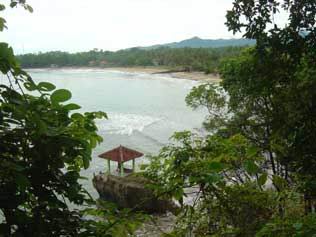Karang Bolong: West Java
 Every once in a while it is nice, if at all possible, to get away from the metropolis that is Jakarta, with all its traffic congestion and choking pollution, and head for the coast to get some sun, sand and reviving sea air.
Every once in a while it is nice, if at all possible, to get away from the metropolis that is Jakarta, with all its traffic congestion and choking pollution, and head for the coast to get some sun, sand and reviving sea air.
Although Jakarta does have coastal areas at its northernmost edges, it is hard to feel that one is really “away from it all” at these narrow little beaches.
Instead, many will travel to the furthest western reaches of Java and to the coastal areas of Anyer and Carita. To get to this part of the island, it is possible to take the Jakarta-Merak toll road for most of the journey.
This road is principally intended to serve as a link to the port town of Merak and the ferries there that depart to Sumatra, but a turn heads to the western coast of Java. Thanks to the toll road, travelers can arrive at the western Java from Jakarta within two hours.
Traveling along the coastal road here, one is confronted by giant industrial complexes that do not suggest that scenic seashores lie ahead. The massive Krakatau steelworks bring heavy traffic to these parts, but perseverance and patience are rewarded.
Traveling beyond the heavy industrial development, one soon passes through the small town of Cilegon and on to the coastal road that hugs the seashore.
Soon, the lineal town of Anyer is reached but there is little here that really constitutes a town. Mostly all that is on offer are cottages and villas offering sandy accommodation.
Probably the most distinguished and literally outstanding aspect of Anyer is its slender and regal white lighthouse, which was erected after the 19th century volcanic explosion of Krakatau that devastated this coastal region.
Passing through Anyer the road continues to hug the shoreline, and gates along the way offer entry to public beaches that give glimpses of the blue sea and distant islands. The road continues to wind toward Carita, but just before it some 12 kilometers from Anyer, one reaches the destination of Karang Bolong.
Care is necessary when approaching this natural wonder, as the entrance gate is narrow and rather hidden on a bend in the road. It would indeed be a shame to miss this site, as it is simultaneously unusual and attractive.
A small fee is charged by the local people to enter this “tourist location” but this should not put anyone off.
Karang Bolong can be translated as a rock or cliff that is “perforated” or “drilled through”, and this is an accurate description. But perhaps some reference to the stone archway here would be a more attractive name, as is this archway that is the site’s most outstanding feature.
The archway is remarkably even and rounded on its underside, but above the cliff face it rises up as an angular and jagged edge. The cliff can be climbed via some steep and heavily moss-covered steps. But the climb is indeed challenging, as trees grow all over the cliff and seem to maraud over the walkway with their branches.
Similarly, the tree roots creep down the sheer rock faces of the cliff, seeking out sustenance. The trees seem precarious dwellers on this cliff, which itself seems to be precariously poised.
At its base, cavernous holes run right through it and the surf washes up against them, striking fears that the whole cliff could crumble and fall into the sea.
Rocky outcrops dot the area, and pagoda-like shelters have been built on some of them, providing shade and a fun place to take a break from the heat of the day. The tide washes in and out around these outcrops, so it is possible, sitting on a huge rock, to be “stranded” momentarily on a tiny island just meters off the shoreline.
Climbing to the top of the cliff allows for excellent views both inland and out to sea.
Looking inland, the small but attractive beach at Karang Bolong can be seen, as can the surrounding hills. Gazing seaward offers a panorama of deep blue waters, and distant cloud-topped islands can be discerned far off in these waters, shimmering in the hot sun.
It is suggested that the Krakatau eruption could have been responsible for carving out the rocks of Karang Bolong into their unusual shapes and sizes. But whatever formed this site, it is clear that the mighty powers of nature were at work.
Just across the coastal road from Karang Bolong, nature is for sale. Surrounding a circular parking lot is a small market where inexpensive seafood can be bought. Also for sale here are many different shells and corals, some of which have been shaped into desk-top ornaments or other decorative affairs.
These, however, give rise to concerns for the local ecosystems. That is, with so many shells and pieces of coral for sale, it may be surmised that much of nature is ruthlessly taken from the sea and exploited for the benefit of tourism.
If so, this would be a shame, for these parts surely need to be protected.
Karang Bolong is a scenic and highly unusual site, and it really ought to be enough to come and take in this sight and appreciate it. It is a popular site at weekends and on national holidays, so take heed that it may get quite crowded.
Even so, Karang Bolong is well worth a visit, as it does illustrate simultaneously the great power and remarkable beauty of nature.
The sea here is clean, clear and blue while the sea air is both fresh and invigorating, thus offering a natural getaway from the hustle, bustle and clutter of the big city.
Simon Marcus Gower: Contributor, Karang Bolong, W. Java